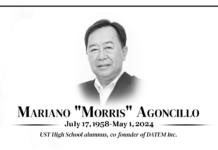A NUMBER of high-profile campus press cases through the years have put to the test the Campus Journalism Act (CJA).
In 1994, the staff of the Chi-Rho of Miriam College caused a campus uproar when it published a literary issue containing sexually charged poems and stories with titles like “Libog,” “Sa Gilid ng Itim” and “Kaskas.”
A Miriam faculty member and a grade school student of another school filed a complaint against the publication with Miriam’s Discipline Committee. The staff protested that the Committee had no jurisdiction on the matter, but the latter suspended some staffers, and expelled others.
The Supreme Court sustained the suspension and expulsion, holding that the provisions of CJA must be harmonized with the academic freedom of school administrators. But, it also ruled that “the school cannot suspend or expel a student solely on the basis of the articles he or she has written except when such article materially disrupt class work or involve substantial disorder or invasion of the rights of others.”
But despite this ruling, some schools have expelled student editors even for articles that didn’t exactly disrupt school operation.
The Dataline of AMA University has been padlocked thrice since 1997 after the release of Amable Tonite, a lampoon issue of Dataline containing allegedly libelous and derogatory articles against the school. After an investigation conducted by the university disciplinary tribunal, some of its staffers were dismissed.
Section 7 of the of the CJA states: “ A student shall not be expelled or suspended solely on the basis of articles he or she has written or on the basis of the performance of his or her duties in the student publication.”
The students filed a court case against AMA and asked for the court to compel AMA to admit them back.
But Judge Percival Lopez of the Quezon City Regional Trial Court in 1997 said the expulsion was valid since the staffers violated the school’s student rules and “with regard to the manner of selecting articles to be published therein. The judge’s decision smacked of giving the administration the right to screen and censor articles and displayed gross ignorance of the CJA.
True enough, the Supreme Court later sanctioned Lopez for “gross ignorance of the law.”
Ernan Queja, the current editor in chief of Dataline, told the Varsitarian that the AMA administration censors their articles.
“The (AMA administrators) trash out our columns and change our editorial cartoons. They also try to block our surveys,” he said. “This is because they do not want anything that would ‘destroy’ the name of the school.”
Queja said that before an issue comes out, AMA administrators send memos to Dataline, asking them to submit their articles. But the Dataline staff continues to fight for more independence, she said.
In the case of Pamantasan ng Lungsod ng Maynila’s Ang Pamantasan, two editors were expelled while 11 staff members were suspended allegedly when they reported about the statements of assets and liabilities of the top school officials. School administrators also revoked the mass communication’s degree of Rose Belen Manaog, the paper’s associate editor.
Maria Cecilia Villarosa, editor in chief of Ang Pamantasan, justified their article, saying “it was done in the interest of transparency with no allusion whatsoever to any probable malversation of funds.”
But, in a statement Bernadette Sacop, dean of student affairs, said the paper raised malicious instructions against the officials. “They (the student editors) were held liable for the malicious statements and publication against the university president and the administration,” she added.
Autonomy
According to Atty. Rene B. Gorospe, adviser of the UST Law Review and professor of constitutional law in the Faculty of Civil Law, student publications, should be allowed a free rein.
“The general rule is that they (school administrators) are not supposed to be doing anything to suppress or even try to cool down the warmth or the zeal of the students in reporting certain cases because the student publication, as the term stands, should be for the students to take care of,” he said.
Gorospe said the school could give general guidelines as to what could be considered as within the school standards, but the school has no right to dictate what to write or what not to write. He added that in extreme cases of irresponsible journalism, the school may discipline the publication for libelous articles or materials that violate its guidelines.
“In extreme cases, the school may come in. But generally, if they come in, it’s after the fact and not before the publication,” he said. A. C. de Alban and M.H. Elmenzo, with reports from J.T. Mendoza and Manila Times.









